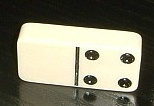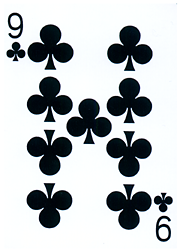Pip (counting)
 From HandWiki - Reading time: 2 min
From HandWiki - Reading time: 2 min
Pips are small but easily countable items, such as the dots on dominoes and dice, or the symbols on a playing card that denote its suit and value.
Dice
On dice, pips are small dots on each face of a common six-sided die. These pips are typically arranged in patterns denoting the numbers one through six. The sum of opposing faces traditionally adds up to seven. Pips are commonly colored black on white or yellow dice, and white on dice of other colors, although colored pips on white/yellow dice are not uncommon; Asian dice often have an enlarged red single pip for the "one" face, while the dice for the game Kismet feature black pips for 1 and 6, red pips for 2 and 5, and green pips for 3 and 4.
Dominoes
Dominoes use pips that are similar to dice. Each half of a domino tile can have anywhere from no pips all the way up to six or nine pips (depending on countries) arranged in the same manner to dice pips. Regardless of dominoes having up to six or up to nine pips on one half of the tile, the game is generally played for up to four players only, individually or in partners (pairs).
Playing cards
In playing cards, pips are small symbols on the front side of the cards that determine the suit of the card and its rank. For example, a standard 52-card deck consists of four suits of thirteen cards each: spades, hearts, clubs, and diamonds. Each suit contains three face cards – the jack, queen, and king. The remaining ten cards are called pip cards and are numbered from one to ten. (The "one" is almost always changed to "ace" and often is the highest card in many games, followed by the face cards.) Each pip card consists of an encoding in the top left-hand corner (and, because the card is also inverted upon itself, the lower right-hand corner) which tells the card-holder the value of the card. In Europe, it is more common to have corner indices on all four corners which lets left-handed players fan their cards more comfortably. The center of the card contains pips representing the suit. The number of pips corresponds with the number of the card, and the arrangement of the pips is generally the same from deck to deck.
Pip cards are also known as numerals or numeral cards.
In point-trick games where cards often score their value in pips (or equivalent if they are court cards e.g. a King may be worth 13), card points are sometimes referred to as pips.
Many French-suited packs contain a variation on the pip style for the Ace of Spades, often consisting of an especially large pip or even a representative image, along with information about the deck's manufacturer.
This article does not cite any external source. HandWiki requires at least one external source. See citing external sources. (2021) (Learn how and when to remove this template message) |
 |
 KSF
KSF


